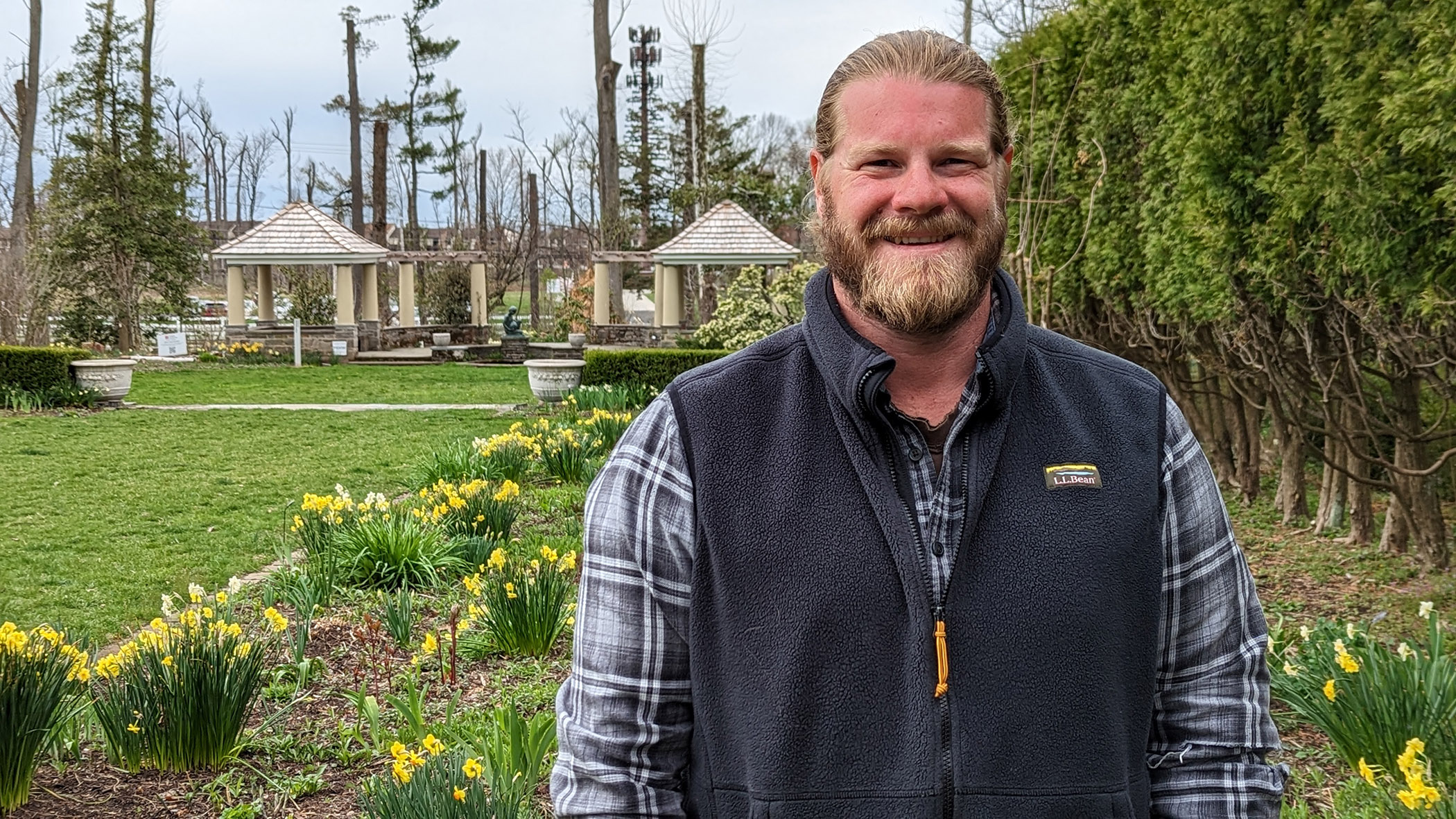Michael Hitchings, Lead Horticulturist for the Ambler Arboretum, is well familiar with the rich history of the Arboretum and the Ambler Campus, recognizing in particular certain inflection points that steered the campus toward the future.
“If you just look back at the timeline of the campus, you find these important changes, when the Pennsylvania School of Horticulture for Women was established in 1911, when the campus became part of Temple in the late 50s and early 60s, these are truly significant moments in the history of the Arboretum,” said Hitchings, a May 2022 graduate of Temple’s Horticulture program offered by the Tyler School of Art and Architecture. “I think we’re living through one of those moments now and I believe we’re meeting the challenges we’ve been given as we rebuild and recover from the 2021 tornado. To be a part of that history and to be part of this Arboretum team means the world to me.”
Hitchings joined the Ambler Arboretum team full-time in November 2022, a little over a year after the tornado struck campus.
“To be able to graduate from the Horticulture program and come right into the mix professionally at the Arboretum working directly on the recovery efforts, it means that I’m helping plan the future of our gardens,” said Hitchings, who started working in the Ambler Arboretum as a student when he arrived at Temple in fall 2019. “I came to Temple when I was 30. Being a bit older and coming in with the experiences I’ve had, I think it was almost fate to be here at this time doing the types of things in the gardens that I was well familiar with — I felt like I was kind of the perfect person for the job.”
Hitchings arrived at Temple with 10 years of experience in landscape management.
“I worked on an extension farm for the University of Maryland before I decided to come back to school. Being able to manage crews, from student workers to volunteers who we truly rely on, that was something I had done in past jobs,” he said. “To be able to use what I’ve learned from this school and use those skills and past experiences to rebuild and reimagine what the Arboretum can be is such a remarkable opportunity.”
As Lead Horticulturist for the Ambler Arboretum, Hitchings oversees “anything that has to do with plants, trees and shrubs.”
“I work closely with the student gardeners and volunteers. We plan out what we will be doing when they are in the Arboretum, and we teach them wide variety of skills, from weeding to pruning, what to do with certain shrubs and trees and how to maintain a landscape,” he said. “Volunteers are crucial to what we are doing well beyond just lending an extra hand. We are a suburban campus in the middle of a large suburban community. Connecting people within that community to the Arboretum is very important.”
Many neighboring communities were also struck hard by the tornado that hit Temple Ambler, Hitchings said.
“Our volunteers are able to find hope here. They are able to come here, get ideas, see what we’re doing, and discover new ways to rebuild their own landscapes,” he said. “That’s very exciting. You’re taking the Arboretum and the teaching that we are doing here and extending it directly into the communities.”
Day-to-day, Hitchings said, he’s additionally focused on transplanting new plants and trees being added to the gardens and “working on an ongoing curational process within the Arboretum.”
“We write down everything about the plants, which in turn is added into the Arboretum’s database. We map plants and trees and come up with watering systems for each location — you have to come up with strategic plans to ensure the plants and trees are getting the water they need,” he said. “This year we’ve been installing larger trees, which I’ve found very interesting. The tornado changed the landscape of the Arboretum and the microclimates of each garden, so we are coming up with new ideas for gardens. We’re trying to determine what works and what doesn’t work; what plants and trees will thrive in these new conditions.”
A primary goal for the Arboretum team, Hitchings said, is “rebuilding the tree canopy while maintaining the existing gardens.”
“We will be planting hundreds of trees over the next few years. I take a lot of pride in the fact that while we may have a small team, we work very well together are able to accomplish huge goals,” he said. “There are always challenges, but it's exciting. It’s like working out a puzzle — how to get it all done efficiently.”
Through the recovery and reimaging efforts taking place in the Arboretum, Hitchings said, the Arboretum team is “doing something kind of unprecedented.”
“I know I will truly appreciate looking back on this place in 60 years, knowing I had a big part in planting all of these plants and designing new garden spaces. To me it’s a priceless opportunity to have,” he said. “Ultimately, our goal is placing the trees we are getting in and designing new gardens — connecting gardens — around them with gardens that have their own unique intentions from history to climate resiliency to simply cool spaces for people to use. We are going to be able to do different things that I’m certain people will really enjoy.”

